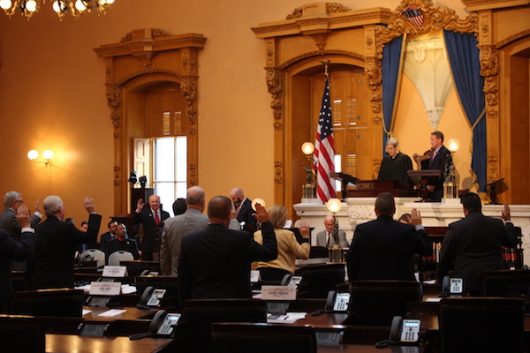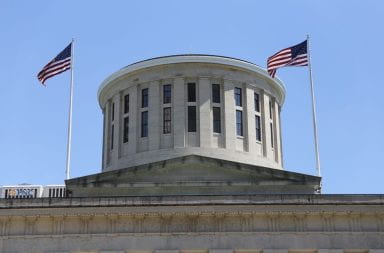
Ohio’s members of the Electoral College take their oath of office before voting on Dec. 19. Credit: Nick Roll | Campus Editor
Ohio’s 18 Electoral College members met on Monday and unanimously cast their votes for Donald Trump for president and Mike Pence for vice president. Although the Republican won the state on Nov. 8, there was speculation — in the shadow of a national campaign run encouraging electors to not vote for Trump — that all 18 of them might not do it.
The vote, though simple and confirming what was expected, was a ceremonious affair. Held in the Ohio Senate chamber, it was complete with a presentation of the colors, pledge of allegiance, national anthem and numerous speakers. Nick Davis, president of Ohio State’s chapter of Students for Trump and a third-year in environmental resource management, led the pledge of allegiance.
Two replacements to Ohio’s Electoral College were made on the Senate floor. Ed Crawford, a Trump campaign fundraiser, replaced an elector who didn’t show, and State Rep. Christina Hagan was replaced due to a pending lawsuit that challenged the legality of a representative being an elector. Robert Scott, a member of Trump’s Ohio campaign, replaced her.
“We will not fear those who wish to curb our First Amendment right to freedom of expression,” Hagan said. “This is the day … that we will confirm the transformation of our government from one muddied by political elites to one for the people and by the people.”
Ohio Gov. John Kasich, who ran for the Republican presidential nomination against Donald Trump, winning Ohio but ultimately losing the nomination, also spoke. Although he did mention Trump, he was less partisan.
“You come here with a heavy responsibility, to cast the vote for the president of the United States,” he said to the electors. “I appreciate you making your way here, I look forward to your vote and the outcome of this vote.”
Nationally, there are 538 electors, including 3 in Washington, D.C. They all met in their respective states to cast their votes on Monday, making the results of Election Day binding. Although Hillary Clinton won the popular vote, she failed to win enough states — and, therefore, enough Electoral College votes — to win a majority in the Electoral College.
The results on Nov. 8 were 306 votes won by Trump to 232 won by Clinton.
There were calls for electors to vote against Trump — and one Texas elector had written in the New York Times that he would vote for Kasich — because of Trump having lost the popular vote, as well as questions critics raised concerning the president-elect’s character. Consensus among U.S. intelligence agencies that Russian-directed hackers stole emails from the Democratic National Committee and Clinton campaign chairman John Podesta, and then leaked those emails over the course of the campaign to help Trump, fueled calls in recent days for the Electoral College to vote against Trump. Trump, as well as officials in Moscow, have said they don’t believe the allegations have credit, but they haven’t provided evidence as to why that is.
Although there have been a handful of cases of so-called “faithless electors” throughout history, and a handful of times that the popular vote and the Electoral College vote haven’t lined up, a presidential election has never been overturned by the Electoral College. Had the Electoral College blocked Trump, the vote for president would have gone to the House of Representatives, which is currently led by a Republican majority and will continue as such in 2017.
Ohio Treasurer Josh Mandel, who recently announced a Senate bid against incumbent Democratic Sen. Sherrod Brown in 2018, delivered the keynote address, where he spoke highly of a future under Trump.
“I think one of the beautiful things of president-elect Trump’s election is that it brought people together,” Mandel said of the election, which has been followed by protests on campus, in Columbus and across the country.
Mandel also brought up the story of Pence being booed by the audience when he went to see the play “Hamilton,” using it to address the protesters outside the statehouse.
“What (Pence) said to (journalists after the incident) was, ‘Those boos we’re hearing, that’s the sound of freedom,’” Mandel said. “Protect that freedom. We should celebrate the fact that people are outside exercising their First Amendment right. But we should also celebrate the fact that we have a great tradition in this country, and that tradition is a peaceful transition of power.”
Like all states, Ohio’s number of Electoral College members is based on its congressional representation. Ohio is represented by 16 members of the House of Representatives, which are allocated based on a state’s population, and two senators.
All states except Maine and Nebraska are winner-take-all states, meaning that if a presidential candidate wins the majority of votes in that state, they receive all of the electoral votes. In Maine in Nebraska, the votes are split based on congressional districts. In Maine, Trump won one of the congressional districts, Clinton won the other, plus the popular vote, so she is set to receive three of Maine’s electoral votes — one is awarded for winning each district, and two are awarded to whoever wins the popular vote — while Trump is set to receive one.
Nebraska’s five electoral votes, which operate under the same system, are set to all go to Trump.
“I think we got the right man, at the right time, in the right place,” Crawford said.
Ohio Senate President Keith Faber concluded the ceremony by wishing everyone in attendance a merry Christmas.


